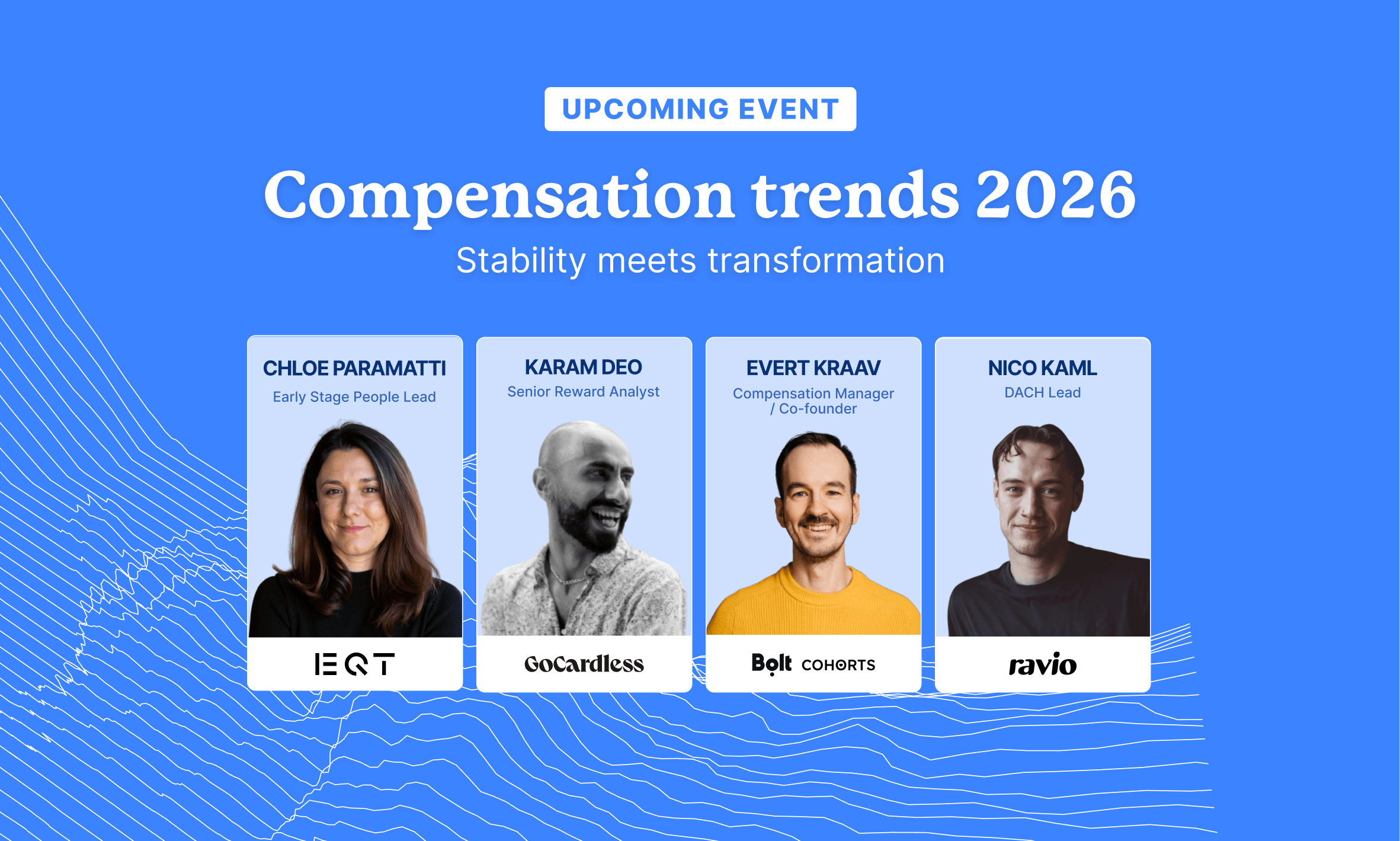"Why would we bring on an entry-level hire when ChatGPT can do the research, data-crunching, and administrative support tasks that our junior talent used to?”
It's a question echoing across tech companies everywhere.
Our latest data shows a staggering 73% decline in entry-level hiring across European tech in the past year alone. AI and the automation of routine tasks aren’t the only reason (the poor economic environment since 2020 has led many companies to cut non-essential hires) but it is a major contributor.
But this isn't just a story about job cuts.
We spoke to Renita Käsper, Global Talent Acquisition & Employer Branding Leader and Co-founder of Cohorts, and Alistair Fraser, Compensation Consultant and Founder of Justly, about the trend. Both emphasised the need for a thoughtful evolution of entry-level roles – designing career starting points that recognise the real value of junior talent.
Subscribe to our newsletter for monthly insights from Ravio's compensation dataset and network of Rewards experts 📩
Is early career hiring in decline?
Early career hiring has taken a dramatic hit across the tech sector in 2025.
For our recent report on the tech job market, we analysed our real-time compensation dataset and found that entry-level roles (those at P1 level) have seen a huge 73% decline in hiring rates in the past year.
This drop in early career hiring far exceeds the overall 7% decrease in hiring rates across all job levels, and puts entry-level hiring rates at just 8% this year compared to 35% 12 months ago.
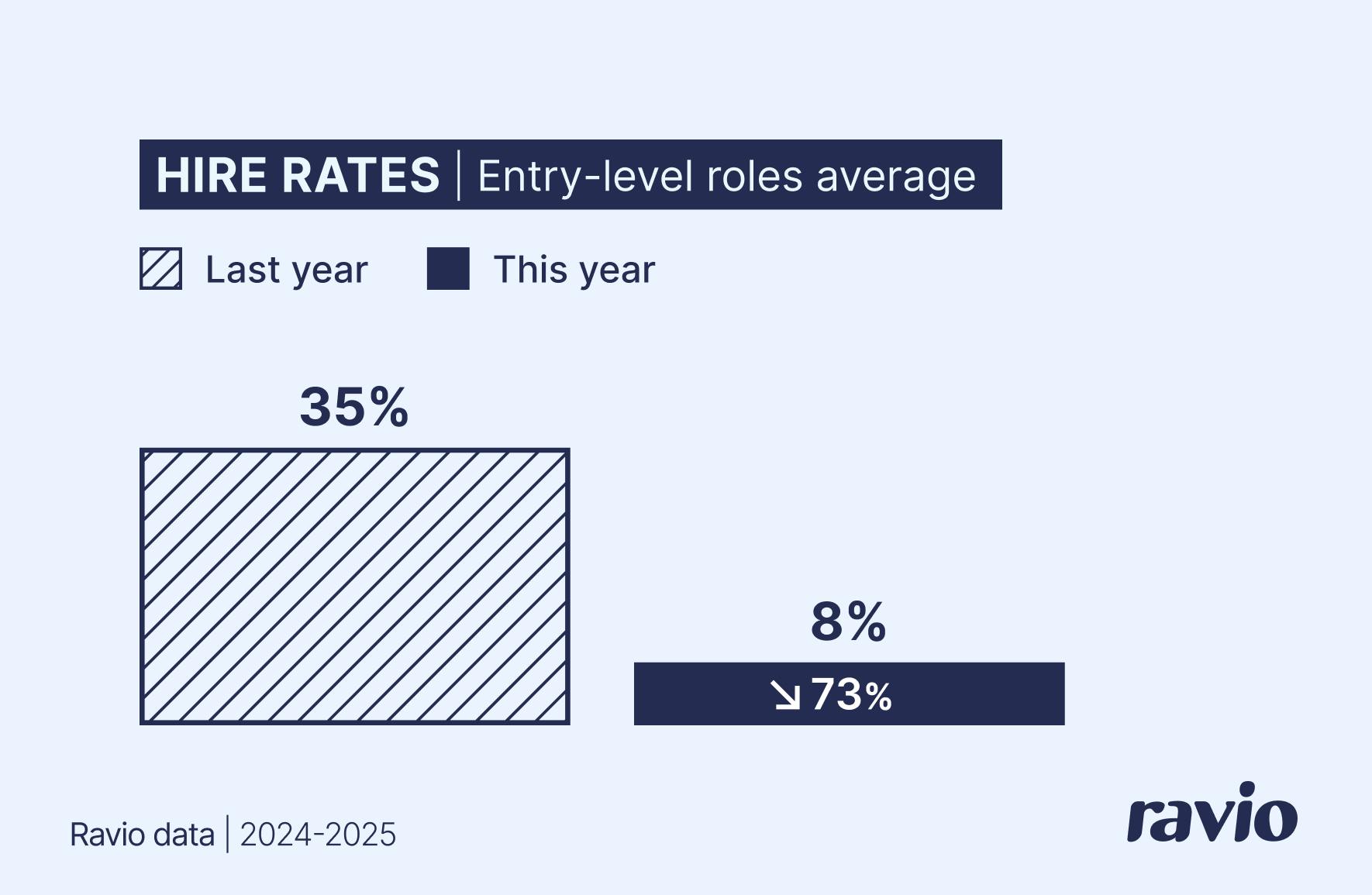
The decline is relatively consistent across all functions, but some areas are particularly affected:
- Marketing: 75.6% decrease
- Engineering: 72.2% drop in entry-level hiring
- People: 72.3% decline
- Product: 69.8% reduction
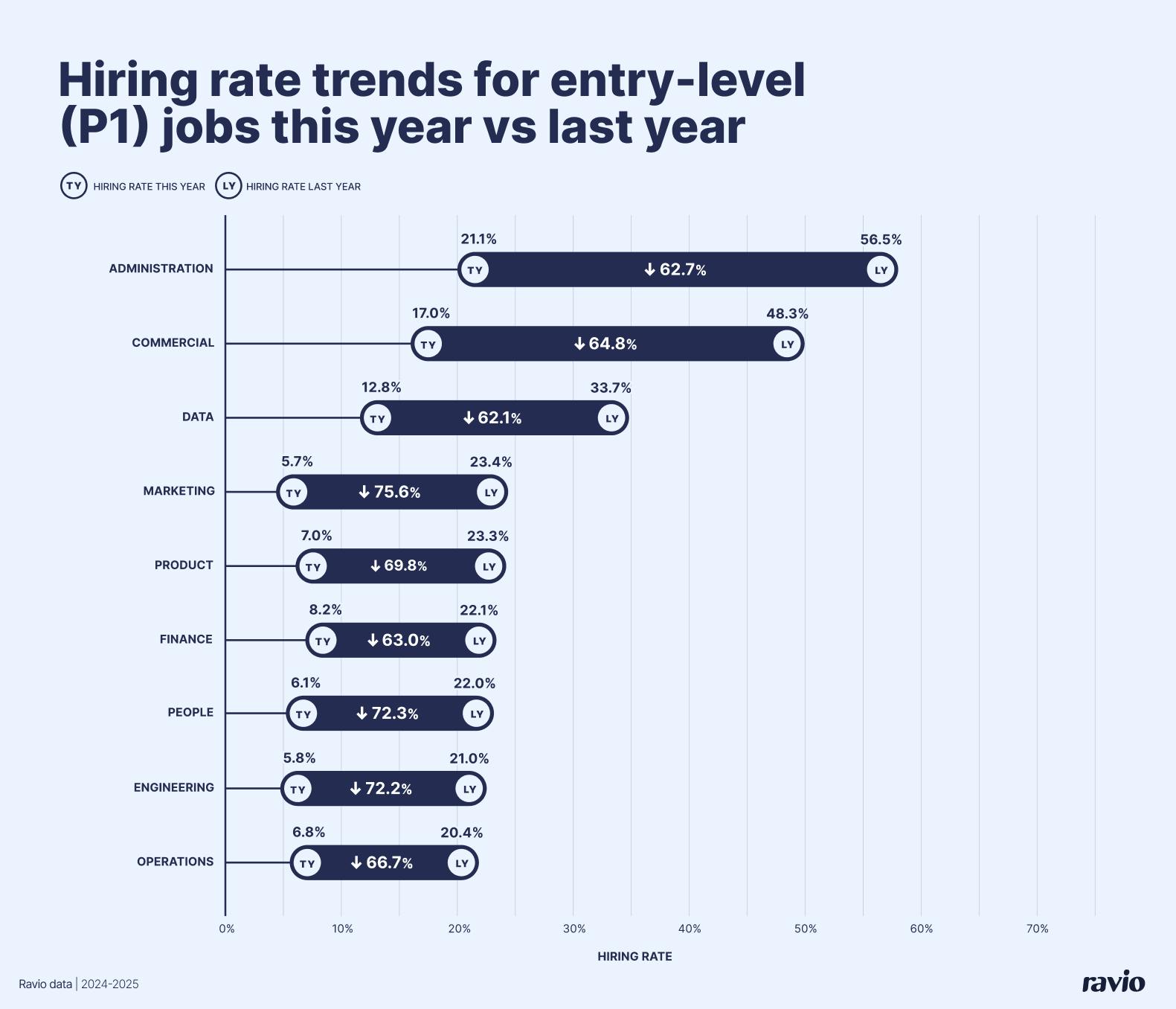
So why is early career hiring in decline?
It’s partly a continued trend of an unstable economic environment and tighter budgets for hiring and compensation. Entry-level roles have become lower priority across the board since 2020, as companies have looked to make efficiencies within their hiring and payroll costs.
However, this doesn’t fully explain the particularly steep decline we’re seeing in the past 12 months.
It seems that the growing use of AI tooling and automation for many of the administrative, support, and coordination-focused tasks that junior roles would traditionally have focused on, might be the culprit – especially in new AI-native startups, who are building much leaner teams of 'super ICs', and foregoing junior and support roles.
When we surveyed Reward leaders about which skills they’re prioritising for hiring in 2025, AI and Machine Learning topped the list by far, with 65% of companies aiming to build AI skillsets this year.
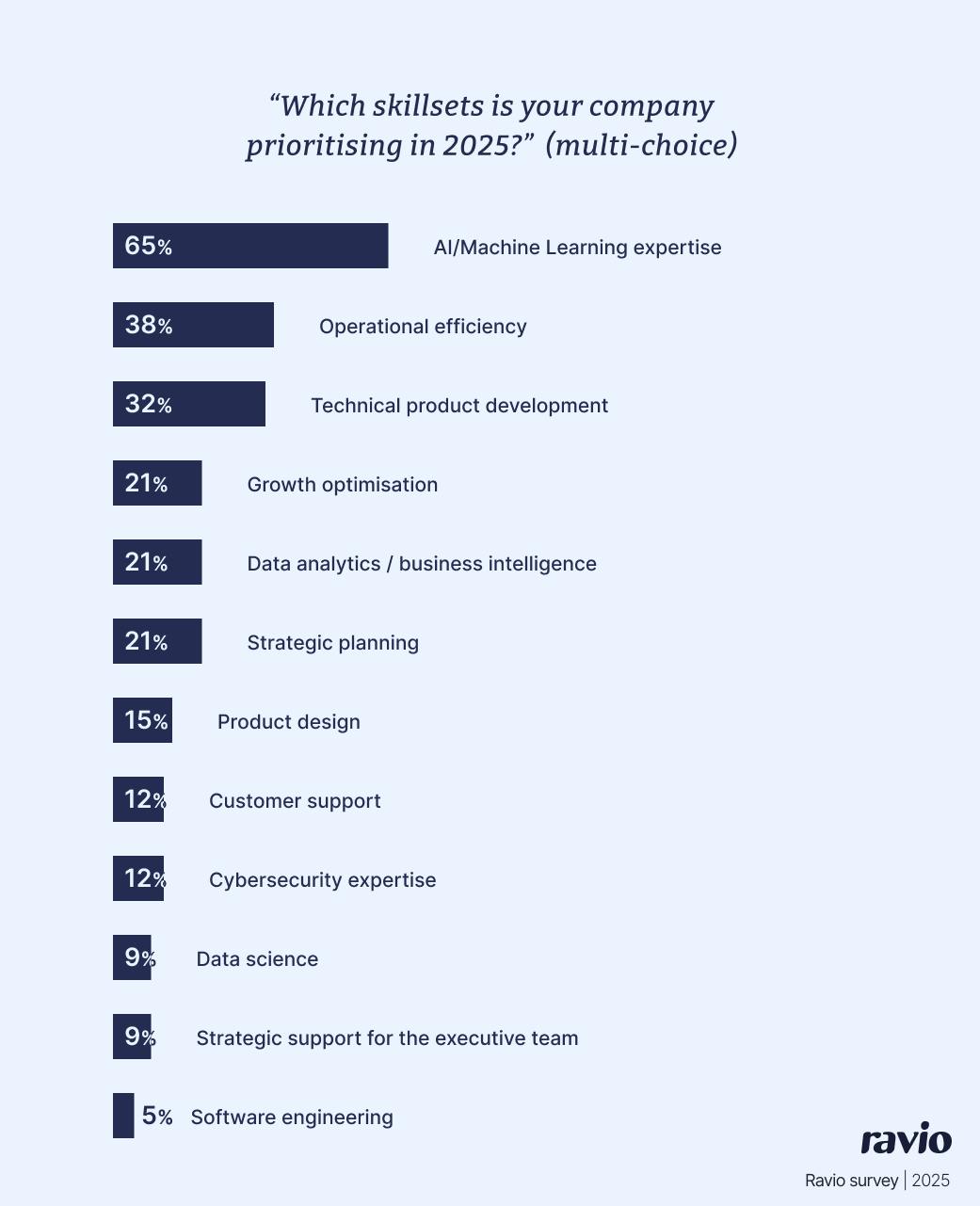
Administration and coordination are bottom of the list, with 38% of companies deprioritising hiring in these areas.
Most explicitly cite AI as the reason for this, with responses like "they can be automated," "AI can substitute," and "we are going to automate processes and have less operative roles” – and this is having a knock-on effect on hiring rates for both administrative roles and entry-level roles.
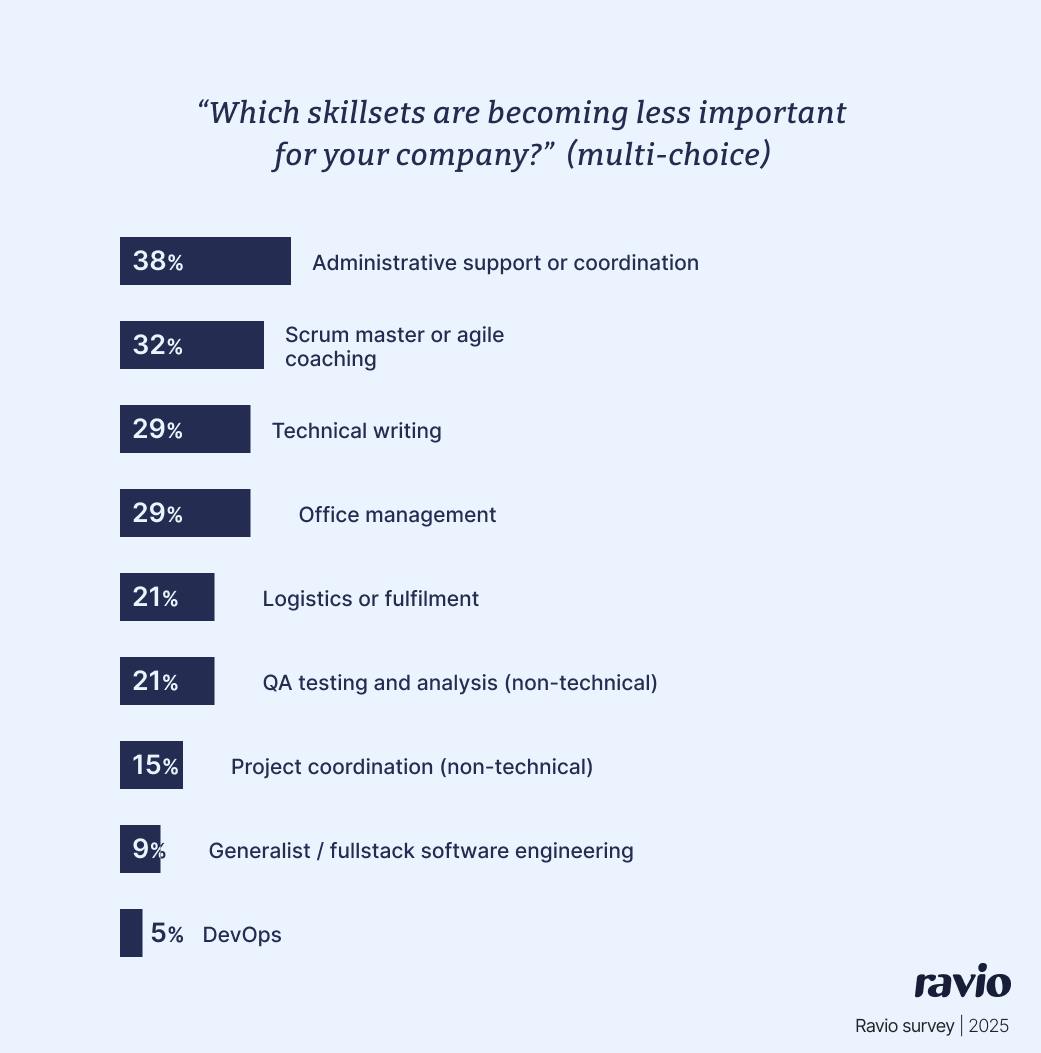
Why cutting junior roles now will create long-term challenges with talent pipeline and innovation
While it might seem logical to cut roles that can be automated, both Renita Käsper (Global Talent Acquisition & Employer Branding Leader and Co-founder of Cohorts) and Alistair Fraser (Compensation Consultant and Founder of Justly) warn that this approach is dangerously short-sighted.
"Companies are jumping on the trend of swapping low-level jobs for AI tooling," she explains. "It's similar to how everyone jumped on remote working when that was a new trend – they're trying it out to see what works. But in this case there’s a lot of future risk involved in reducing or removing junior roles."
Alistair agrees: "We shouldn't write off entry-level roles just because some tasks are being automated,” he says, “AI might be able to pick up some of the admin-heavy tasks, but it’s clear there are lots of things it can’t do very well too.”
The biggest risks? Future talent pipeline and innovative thinking.
Talent pipeline: The succession planning gap
The most obvious risk is to your talent pipeline. Entry-level roles have traditionally been a way to cultivate employees who have deep internal expertise and culture alignment, who will make perfect candidates for future management and leadership roles.
“If you don’t hire and nurture young talent now, what will your mid-level and leadership positions look like in five years?” Renita asks. “We’re heading towards some very difficult and expensive recruitment to fill that gap in a few years time.”
Further, Alistair emphasises that even as AI handles more routine tasks, human skills remain essential. "We still need people who are able to oversee projects with creativity and human judgment in areas like People Operations, for instance,” he highlights.
“If we don't provide young people with the foundations and learning opportunities, we'll lose that."
Instead of promoting internally and backfilling junior roles at lower cost, you'll end up competing for mid-level and senior hires at market premiums.
💡How do you build a strong internal talent pipeline from entry-level to future leader?
Alistair also highlights that the drop in entry-level roles isn't the only factor causing companies issues with their internal talent pipelines and succession planning.
Developing junior talent into future leaders has always taken time, structure, and intention," he says.
"Companies should only hire in entry-level talent once they have the scaffolding in place to support them. I've seen a lot of early-stage startups recognise that during the early phase of building the product and the company, hiring junior people isn't the right move, because the support they need won't be there."
So what does that 'right setup' look like?
For Alistair, the non-negotiables are:
- Clearly defined job levels and progression frameworks to enable junior talent to see their career pathway within the company
- Budget and resources to support learning and development programmes
- Managers and leaders with the training and headspace to be able to coach and mentor junior talent properly.
Innovative thinking: Missing out on new perspectives and AI native thinking
Another concern is that companies are overlooking the value that young talent actually brings to the table.
“If junior talent can be replaced by AI, we’re saying that all they ever offered was a cheap way to get our admin work done, but that’s so far from reality” says Renita. “You’re missing out on the creative ideas, diversity of thinking, and savviness with new technologies (like AI itself) that new generations bring to the workplace.”
There’s a particularly obvious irony here that companies are looking to build their AI capabilities fast and are ditching junior roles to make space for that – but it’s those junior employees who might have the best understanding of how AI could actually be integrated into workplaces in an impactful way.
The opportunity: What does a great career starting point look like in the AI era?
Both Alistair and Renita agree that the widespread adoption of AI does mean that early career roles will need to evolve.
In fact, Renita's own career illustrates how entry-level roles have already evolved significantly over the past decade due to technology.
She started in sales development, where her team shared "one phone and one huge book of yellow pages," racing to get past secretaries to reach decision makers and earn commission.
"Technology has already changed that role so much,” she reflects, “and now AI tools are taking it even further – AI SDRs can now handle those time intensive, repetitive outreach tasks for sales teams.”
For Renita, this shift represents a chance to fundamentally rethink what entry-level roles can offer – both to young talent and to the businesses that hire them.
“We shouldn’t be aiming to eliminate these roles, we should be redesigning them into something that’s actually valuable for young talent and for companies.”
So what could that evolution look like?
Early career roles that prioritise emerging skillsets
The days of graduates doing coffee runs and taking meeting notes are over, and it’s time to find faster ways to meaningful value from junior talent.
For Alistair, a great entry-level role is one that “exposes people to real projects, with real problems and real decision-making processes”.
Renita agrees, and both see particular potential for bringing entry-level talent straight into mature projects focused on emerging skillsets like AI integration.
“Like with any technological advance, it’s the younger generations who pick it up most quickly” Renita highlights.
“They’re already AI fluent because they’re using tools like ChatGPT in their everyday life, and that means they have knowledge that’s really valuable for companies right now. There’s a huge opportunity to design roles that harness that knowledge to drive impact.”
Learning and mentoring focused on business acumen and soft skills
Whilst young employees may bring deep knowledge of AI to the table, Alistair is concerned that the use of AI in the workplace will lead them to lack other critical competencies.
“The skills that entry-level roles used to build – like real-world problem solving, critical thinking, learning from mistakes – are being eroded by our growing use of AI,” Alistair explains.
“We're raising a generation that is being taught to outsource their thinking. Skills that entry-level roles used to build – like learning from mistakes or forming opinions or critical thinking on real-world problems – are being placed by the convenience of instant answers.”
“These aren’t just workplace skills either. As a father myself, what really worries me is the impact on agency: the capacity of young people to make free and independent choices about the direction of their own life. I want my kids to grow up with that intact.”
So what does this mean for how we shape early career roles? For Alistair it’s all about ensuring that early work experiences (as well as education too) focus on:
- Developing soft skills. Problem solving, critical thinking, relationship-building, adaptability – these should all be front and centre of how employees make decisions now and still in an AI-integrated future.
- Incentivising deep work. Giving young talent projects and goals where creativity and deep thinking are actively encouraged, rather than the speed of output. Early career roles should be environments where young people practice making decisions, applying judgment, and learning how and when to think for themselves without using AI as a constant crutch.
- Educating on AI. Teach employees (of all stages) what AI actually is and how it works, rather than just how to prompt it or use it to be more efficient. This is key to building critical thinking on how AI should be used in the workplace (and when it shouldn’t).
- Educating on the wider context of AI adoption at work too. Junior talent might come to us with a higher understanding of AI, but they will lack vital context of what used to be manual and how it’s now being automated that, again, informs when AI should be applied in business contexts.
To ensure junior talent gets the training and support needed, Renita sees huge potential for incorporating “reverse mentoring” into roles – where junior employees train existing staff on using new AI tools, and in return receive mentoring on business processes and commercial thinking from more experienced colleagues.
"Young talent could be the ones training existing employees on prompt engineering and supporting existing teams to embed AI tools," she explains, “whilst recognising that they will need training and support in other areas of development.”
A skills-based approach to early career hiring and compensation
This shift towards valuing emerging technical skills alongside traditional development needs creates new challenges for compensation teams.
It's a dilemma Alistair acknowledges doesn't have easy answers yet.
"On one hand, some junior hires may genuinely bring in high value AI skills – the kind of capabilities that companies are willing to pay a premium for,” he points out, “But at the same time, they often will not yet have developed the other critical skills that make someone effective in a team."
"It is one thing to know how to write code or chain together models. It is another to explain what you are doing, why it matters, and how it fits into a wider business or product goal," he explains.
One thing is clear: defaulting to levelling all entry-level candidates at the traditional P1 bottom rung of the career ladder may no longer make sense.
“It might be that they’re a P1 in terms of scope and communication, but a P4 in terms of technical depth,” Alistair suggests.
Renita sees the same challenge. For her, this idea of an employee who is skilled in some areas, but lacking in others, lends itself to a more skills-based approach:
- Review your level framework. Ensure job level definitions reflect the skills that the business actually needs to succeed. If AI integration is business critical, then AI expertise should be a core competency reflected in progression through job levels.
- Recognise expert knowledge where it exists. When hiring, focus on the skills the business needs rather than years of experience. Then, when determining compensation, evaluate their level of seniority for each relevant skillset. If someone brings valuable AI skills but is inexperienced in other areas, their salary band position should reflect that higher level expertise.
- Be transparent about growth areas for all employees. Clearly outline where development is needed for all employees. This is where Renita’s reverse mentoring concept becomes particularly valuable. Younger employees can learn business skills from experienced colleagues to support their development, whilst sharing their own AI expertise with those colleagues to help them progress in this new skillset.
The clarity this brings benefits everyone: job adverts become more targeted, candidates understand their pay and development areas, hiring managers get better-matched applicants, and compensation decisions become more defensible.
"Unclear job ads leading to piles of unfit candidates are the biggest issue I see in hiring," Renita notes. "With a skills-based approach, you can be much more transparent and targeted – we need this AI skill, but if you have less experience on stakeholder management that's fine. It’s so much more efficient."
Don’t just cut early career roles, evolve them to fit new needs
The 73% decline in entry-level hiring is a major concern, but it also represents a major opportunity.
Companies that proactively evolve career starting points into roles that provide real value for all involved, rather than simply eliminating junior roles, will build strong talent pipelines while capturing the AI fluency and innovative thinking that younger generations bring.
Those that don't may find themselves scrambling to fill expensive succession planning gaps in just a few years' time.


